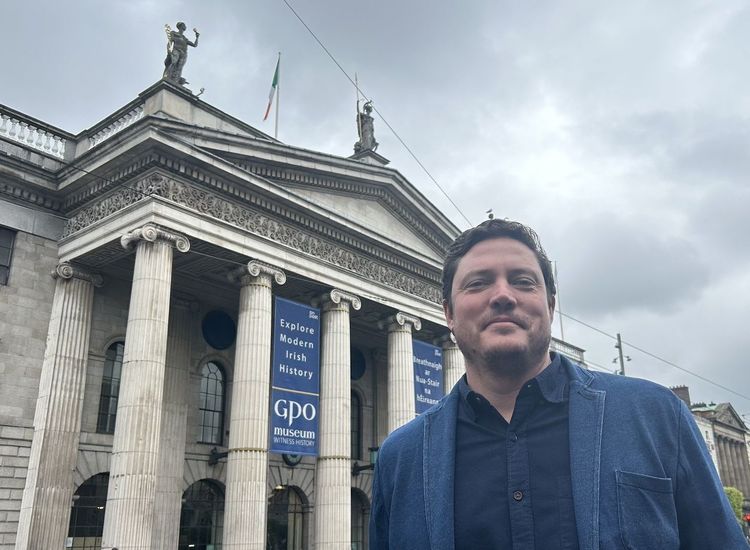Traditional Music / By Daniel Neely
Welcome to “The Scrum,” or what is probably the most densely packed week of the 2018 traditional music calendar! Now is when thousands of people from all over the world find themselves visiting the well and renewing their connection to traditional Irish music at places like the Willie Clancy Summer School, the Swannanoa Gathering, and the Catskills Irish Arts Week (and maybe others I don’t know about!), all of which are happening right now. It’s a pretty intense time.
This week I’m going to discuss a pair of exceptional albums that will surely be the talk of these festivals, and ones you should absolutely have in your collection if you do not already.
First up comes the self-titled debut from “The High Seas,” a band that comprises Cathal Ó Curráin (vocals, bouzouki & fiddle), Ciarán Ó Maonaigh (fiddle and octave fiddle), and Caitlín Nic Gabhann (concertina, dance & foot percussion). This self-titled debut includes some brilliant playing and a handful of really wonderful songs that are absolutely wonderful.
Many of this column’s readers will likely be familiar with Ó Maonaigh and Nic Gabhann. A married couple, they both come from important musical families and are top-class players. Nic Gabhann is a three-time All-Ireland champion, was a dancer with “Riverdance” for two years, and has been a member of the groups NicGaviskey, Birkin Tree and the Irish Concertina Ensemble. Ó Maonaigh, on the other hand, was TG4’s “Young Musician of the Year” at the 2003 Gradam Ceoil, a member of the band Fidil, and also produces music documentaries for TG4 and RTE. Both are in-demand instructors, and together in 2015 they recorded the lovely album “Caitlín & Ciarán.”
Ó Curráin is the least known of the three. Like Ó Maonaigh, he grew up in the Gaoth Dobhair gaeltacht in County Donegal and he is currently a student of music and dance at the University of Limerick. (The press release reveals he’s just 19 years old.) His relative obscurity should be short lived, however, because his singing and musicianship here do a good fair bit of the album’s heavy lifting and together form one of it’s great attractions.
The first thing that might be said about this album is how natural Nic Gabhann & Ó Maonaigh’s ensemble work is. There are six instrumental tracks, and in them they make clear not just the affinity each has for the other’s music but the undeniable chemistry they share as performers. What’s more, though, is how well Ó Curráin is able to find a complementary place in their groove. You can hear this on tracks like “Tomás Clancy's No. 2 / …,” “Éigse An Spidéil / …,” and “The Drunken Landlady /…,” where the three work within textured, nuanced arrangements in creating some very appealing instrumental music.
The album also includes five vocal tracks. Ó Curráin’s singing is wickely nice – he has a wonderfully clear voice and phrases beautifully. Standouts for me include “Road to Donegal,” “An Cailín Rua” (which includes some lovely tunes and percussive footwork), and “Máire Ní Eidhin,” which are all fabulous. I think many listeners of this album will be drawn to Ó Curráin work in particular.
Well-constructed arrangements, tastefully done percussive dance, and excellent songs give this album a great deal of variety that I’m certain translates beautifully to live performance. There’s a lot going on for only three musicians, and they’ve hit all the right notes in terms of tonal setting. That there are only three folks in the group, two having substantial performance experience and one possessing a charming youthfulness in his delivery, should also make this band a very attractive for tour promoters, so if they come to your neck of the woods be sure catch them. In the meantime, head over to caitlinciaran.bandcamp.com to have a listen and pick up “The High Seas,” it’ll be well worth your while.

The second album is “The Legacy of Stephen Grier: music from one of Ireland’s treasured 19th-century collections"” by Séamus McGuire (fiddle) & John Lee (flute). It’s a brilliant and brilliantly constructed album from two top players that explores repertory captured in a manuscript assembled in a bygone day.
Born in Longford in 1824, Grier – the manuscript at hand’s compiler – married and moved to Newpark, Bohey, Gortletteragh in south Leitrim in 1852, and died in 1894. During that time, he collected tunes. Mostly compiled in the early 1880s, the Stephan Grier manuscripts are known as “one of the most comprehensive collections of 19th-century Irish music” and comprise approximately 1000 tunes spread out over twelve manuscripts and provide modern-day scholars a snapshot of what the music of south Leitrim was like at the time. Included in the collection are continental dance tunes, military-style marches, airs, and strathspeys in addition to the expected rake of jigs, reels, hornpipes. That almost all of it is unpublished (Breandán Breatnach included 64 of his tunes in his fourth volume of “Ceol Rince na hÉireann” [1996]) makes the contents of this album even more interesting.
The album includes lots of great and really very unusual tracks. For example, the first, “Planxty 12,” will have considerable interest for many, as it appears to be a tune that is newly-attributed to Turlough O’Carolan. (An interesting note: although separated by over 100 years, Carolan and Grier settled in nearby parts of Leitrim, and the liner notes playfully float the notion that the tune could have had a local life and that Grier may have learned it in a direct line of transmission from Carolan.) “The Fourth Dragoon’s March” is a fascinating piece of music that I imagine will catch a few ears. “Stephen Grier's Polkas” is also lovely track from Greir’s day, and interesting because the first tune shares a section with a barn dance Michael Coleman recorded. I think “The Straddy / …” is an excellent set of tunes (“The Races of Granard” is a standout here) and I have a similarly high opinion of the “Walk on the Darógs Set” because both contain some great and unusual tunes.
Guest artists include Floriane Blancke (harp), Manus McGuire (fiddle), and Garry Ó Briain (mandocello/piano/guitar), all of whom enhance the album’s overall quality.
“The Legacy of Stephen Grier” is a spectacular, multidimensional album set apart by two things. First is the musicianship, which is top notch. McGuire and Lee’s approach is relaxed and elegant and affords the tunes space to to shine and be beautiful. They are to be especially commended for how their playing feels at once rooted in Grier’s time and in the present day. Second, however, is the amount of research that very clearly went into this project. It is substantial and sheds musicologically satisfying light on both Grier’s life and the contents of the manuscript. If indeed Grier is to be remembered as “one of the most important collectors of Irish music,” as the liner notes suggest, then this album surely strengthens the case substantially. Outstanding stuff, indeed. To learn more, visit mcguireleemusic.com.










